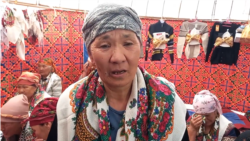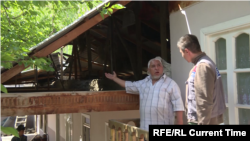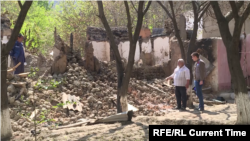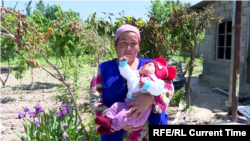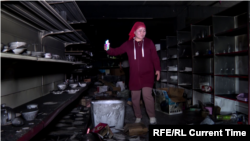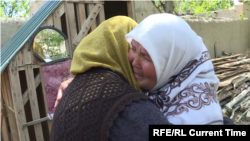Three days after a May 1 ceasefire that ended intensive fighting over water resources, residents of Kyrgyzstan and Tajikistan’s border areas are struggling to rebuild their lives. While the ceasefire reportedly is holding, as yet, long-term solutions for the problems that contributed to the conflict appear outstanding.
Fighting erupted on April 28 after a scuffle between Kyrgyz and Tajik civilians over a Tajik attempt to install a surveillance camera at the Isfara River’s Golovnoy pumping station following a Kyrgyz repair. Both countries claim ownership of the station and a reservoir, which provide water for tens of thousands of hectares of land.
The violence spread quickly, with artillery wiping out residences, schools, and stores in border areas, and creating tens of thousands of evacuees. Kyrgyzstan has announced 36 deaths and dozens wounded. Tajikistan has not released casualty figures, but Radio Free Europe/Radio Liberty’s Tajik Service has confirmed the deaths of 16 people, both military officers and civilians.
In this heavily populated area of Central Asia, ethnic Kyrgyz and Tajiks have skirmished for decades over water and territory in the Isfara Valley, but without massive losses of life and property. Villagers interviewed in the two countries’ border regions of Batken (Kyrgyzstan) and Sughd (Tajikistan) said that they had expected this time to be no different.
But the devastation shows how far they were wrong.
On the morning of April 29 in the Tajik village of Somoniyon, Komil Muminov, a white-haired, middle-aged man, was sitting at home with his wife, children, daughter-in-law, and grandsons, when shells destroyed part of his house’s roof, a wall, and an entire room.
Showing the damage to his house, Muminov still appeared dumbfounded by the attack. “I thought they wouldn’t reach us, and we were calm,” he recollected.
None of his family members, who took refuge in another structure, were wounded in the attack.
The house of Muminov’s neighbor, however, burnt to the ground. The neighbor’s son was wounded while Muminov and the man were trying to put out the flames.
Fear of alleged Kyrgyz snipers in the hills overlooking the road to Somoniyon prompted Sharif Nazarov to restrain himself and simply watch from a distance when he saw his own house in Somoniyon catch on fire from a projectile. Another such strike reportedly leveled a building that housed 18 people.
The Tajik government announced on May 3 that it had evacuated more than 15,000 people from border areas to escape the fighting. No information was provided about their destination. Despite the high number, it claimed that all of them have since returned home.
What official measures are being taken to help them have not been specified, but local emergency officials in northern Tajikistan have announced plans to assess the damage to houses in the Tajik exclave of Vorukh, inside Kyrgyzstan, and in the villages of Surkh, Chorkukh, and Ovchikalacha Bobojon.
In Somoniyon, from which around 350 women and children were evacuated, resident Okhista Sharipova, is one of those who fled on her own and has returned. The grandmother who hid from the shelling with her family in a basement, insisted that villagers will return, despite the destruction. “Their homes and homeland are here,” Sharipova said. “They can’t get rid of us that easily.”
That sense of despair and anger extends over the border into Kyrgyzstan.
In the village of Makrat, nothing but charred ruins remain of the three-room house that the husband of Maylyuda Abdrakhmanova “worked his whole life” to build. With her husband now working in Russia to earn money, Abdrakhmanova -- the mother of five children, the youngest of whom is three months old -- must sort out the family’s immediate future on her own.
Abrakhmanova and her children are now living in the house of her brother-in-law. The dwelling, the only one of three Abrakhmanov family houses left standing, contains three families, each with three to five children.
Abrakhmanova’s sister-in-law, Dirshoda Murzaliyeva, questions how they can all stay in Makrat, where lack of work amidst the pandemic forced all three Abrakhmanov brothers to migrate to Russia.
Weak social-welfare nets and a moribund agricultural economy mean recovery options are few.
In Arka, another Kyrgyz border village, Tolgonai Arapova, owner of the village’s largest retail store, said that if the Kyrgyz government cannot pay adequate compensation for her losses, she may have to return to work in Russia to meet expenses.
Representatives from Kyrgyzstan’s Ministry of Emergency Situations have been assessing the extent of the damage to buildings in Arka.
Kyrgyzstan has reported that some 33,000 people were evacuated from villages in the Batken region. Many were sent to the regional seat, Batken, where public schools and private hotels offered accommodation for those not taken in by individuals. Locals donated food, diapers, clothing, and medicine.
After she returned from a police-mandated evacuation, Arapova found her general-merchandise store, which sold everything from washing machines to shoes, burnt and ruined.
“We didn’t think that such a thing could happen …” she said. “We thought that everything, like usual, will quiet down.”
How to ensure that fighting does not reoccur appears to be an open question. “I don’t know what the government is doing to resolve this conflict,” commented one young man, who showed Current Time through the ruins of a burnt house in the Batken region.
In a videoed May 1 statement after announcement of a troop withdrawal and ceasefire, both Kyrgyz State National Security Chairman Kamchybek Tashiev and Tajik State National Security Chairman Saimumin Yatimov stressed their readiness for peace.
Deciding on the roughly 970-kilometer-long Kyrgyz-Tajik border appears to be the first priority. Although just 52 percent of the border has been delimited and demarcated over the past 30 years, the two sides claim they can finish the job promptly. By May 9, a joint border commission will decide on 112 kilometers of the border, the Kyrgyz government has pledged.
One Central Asia analyst calls that target and deadline “fantastic.” An extensive population, complex geography, and the heavy need for water mean that such negotiations will require “months and months” of work, objected Stanislav Pritchen, head of the Russian Academy of Sciences’ Center for the Study of Central Asia and the Caucasus.
Compelling locals “to accept the fact that the boundaries and habitual areas of life are changing” is also “very difficult,” Pritchen added.
Local officials also do not “enjoy the full measure of power that the central authorities [in Bishkek and Dushanbe] can give them,” objected Temur Umarov of the Carnegie Moscow Center.
Water management is equally pressing. Despite a growing population on both sides of the border, modern methods for providing water, such as drip irrigation, are not widespread, commented Grigory Mikhailov, a Central Asia expert at Moscow’s Institute of CIS Countries think-tank. The trend is for the amount of water in regional canals and reservoirs to decrease.
“Either people will learn to economize this water, or these conflicts will continue with even greater fierceness,” Mikhailov cautioned.
Smuggling networks, local officials with little real power, and widespread private ownership of firearms add to the problem, Mikhailov and Umarov said.
“[A]t the given moment, the ongoing conflict has not yet been finally extinguished,” commented Mikhailov. “There’s a risk that it will return and turn into a conflict in the so-called hot phase.”
“[A]s long as those issues that exist on the ground won’t be resolved by the two countries’ political forces, we, unfortunately, will continue to see such conflicts,” predicted Umarov.
-Fatality numbers for Kyrgyzstan were updated on May 4, 2021.





